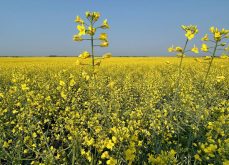Glacier FarmMedia | MarketsFarm—Canola prices at the Intercontinental Exchange (ICE) were on the rise for most of the week ended Aug. 28, until the release of Statistics Canada’s (StatCan) production estimates for the 2024-25 crop year on Aug. 28.
The November contract gained C$18.20 per tonne from the previous week to close at C$595.80 on Aug. 28, despite losing C$3.20 that day.
Jerry Klassen of Resilient Capital in Winnipeg explained that increased foreign and domestic demand, as well as higher vegetable and crude oil prices and crush margins, helped raise prices for the oilseed.
Read Also

U.S. grains: Wheat recovers on short covering, soy continues to fall
Chicago | Reuters – Chicago wheat futures found their footing on Thursday on short covering but remained near eight-week lows…
“Last week, China was buying a lot of U.S. soybeans. (I can’t confirm but) usually, they buy canola at the same time,” he said. “I think there were some ideas (from the trade) there was some export business being done … Overall, you have all these factors pulling the canola market prior to the StatCan report.”
StatCan estimated Canada’s canola crop to total 19.502 million tonnes for the 2024-25 crop year, compared to the revised figure of 19.192 million in 2023-24. Klassen said the trade considers StatCan’s August estimates as “a stab in the dark” while it waits for more information as the canola harvest progresses.
“The early yield reports (in Alberta) don’t really reflect what StatCan said. Now in eastern Saskatchewan and Manitoba, I think there are some growers who are expecting record-type yields,” he added. “This year, more than ever, it’s not like there were blanket conditions across the Prairies … To say that 19.5 million is too high or too low, at this stage, I think it’s a premature guess at the high end of trade estimates.”
Klassen added that while StatCan may have accurately pegged canola yields in Saskatchewan and Manitoba, the agency tends to overestimate yields in drier areas, such as Alberta this year.
“Because (the modelling) was done in July, I think we saw (Alberta’s canola) crop was in severe deterioration at the time, but we probably didn’t get the full extent in Alberta,” he said.
The trade may be treating the StatCan report as bearish, realizing it may have underestimated yields in Saskatchewan and Manitoba, according to Klassen.
“(The trade) is probably thinking this number’s going to grow a bit until the December report,” he said.
Average quality should be expected for most of Canada’s canola crop and with the November/January spread currently exceeding C$10/tonne, Klassen said it’s a sign that there are no concerns over supply.
“It tells us that crushers have pretty good coverage for the next two or three months and commercial stocks are pretty high for this time of year,” he added. “Everybody’s kind of bearish on the market here because we’re going into harvest and new canola is entering the system. That’s going to keep the spreads wide, that’s going to keep the basis under pressure and that’s going to be negative for the futures.”
















